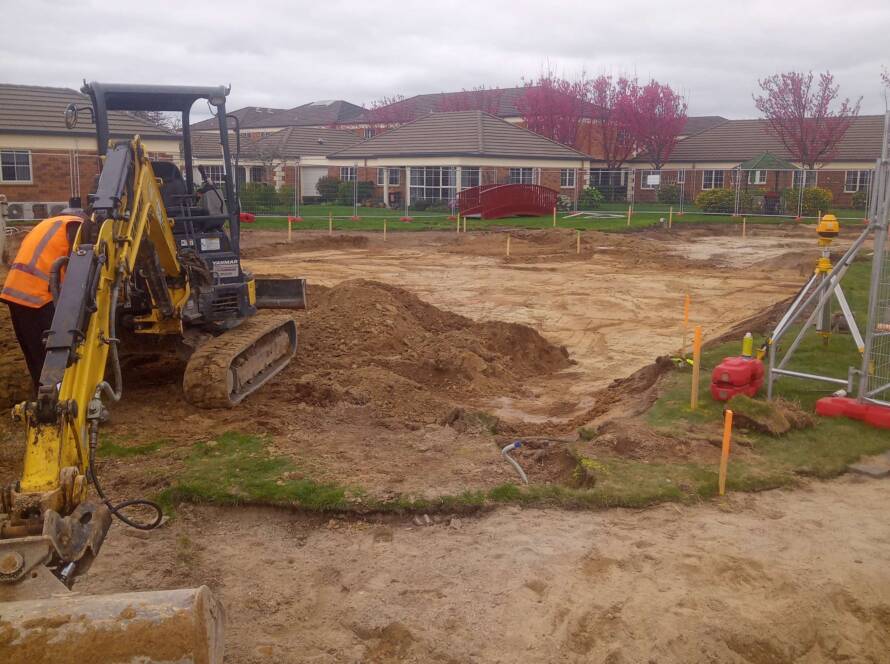Bulk excavation is a fundamental process in construction. Essentially, it refers to the removal or addition of large volumes of soil, rock, sand, and other materials from a site to prepare it for civil construction. This type of excavation is commonly used in the early stages of projects such as road construction, large building foundations, and underground utility installations, where the land needs to be at the correct level and suitable for the construction that will follow.
Key Applications of Bulk Excavation
Residential Construction
In residential construction, bulk excavation is often required to prepare land for housing developments. For example, if a new subdivision is being developed, large amounts of earth might need to be removed to create level plots for homes or to carve out basements.
Commercial Construction
When constructing large office blocks or retail spaces, significant excavation may be required to lay the foundations or create underground parking facilities. In urban settings, where space is at a premium, bulk excavation might be necessary to develop underground commercial spaces, such as parking lots or storage areas. This type of excavation ensures that the commercial structures above are safe and stable, providing a secure environment for future occupants.
Bulk Excavation Level
This level refers to the final elevation or depth of the excavation site after the bulk of the soil or rock has been removed or added. The goal is to create a stable, level foundation that meets the project’s specifications.
Calculation and Precision
The determination of the bulk excavation level involves detailed surveys and calculations. Engineers and surveyors utilise advanced tools like Total Stations and GPS-based systems to measure the existing ground levels and calculate the necessary cut and fill volumes. The aim is to bring the site to a predetermined level, ensuring it is flat and stable.
This process involves several steps:
- Initial Surveying: Capturing the topographical data of the site, which provides a 3D model of the existing ground conditions. This model is then used to identify the high and low points of the site relative to the planned excavation level.
- Volume Calculations: Using the topographical data, engineers calculate the amount of material that needs to be removed (cut) or added (fill) to achieve the desired level. These calculations are typically done using specialised software that can model the excavation process and predict the volumes with high accuracy.
- Excavation Execution: Heavy machinery is then used to carry out the excavation based on the calculated cut and fill requirements. The use of GPS-guided machinery ensures that the excavation is carried out with millimetre precision, reducing the risk of over-excavation or under-excavation.
- Verification and Adjustment: After the bulk excavation is completed, a secondary survey is conducted to verify that the actual excavation matches the planned levels. If discrepancies are found, adjustments are made, which may involve additional excavation or backfilling to achieve the exact design specifications.
Equipment Used for Bulk Excavations
Bulk excavation relies on an array of heavy-duty machinery, including;
- Excavators and Bulldozers: For removing and relocating soil and rock.
- Dump Trucks: For transporting materials off-site or to designated storage areas.
- Graders and Compactors: To level and stabilise the site after material removal or addition.
- Specialised Equipment: In cases involving hard rock or deep excavations, tools like rock saws, blasting equipment, or high-reach excavators may be required.
The type of machinery used depends on the nature of the soil or rock and the size of the area being excavated. When dealing with hard ground, specialised equipment like rock saws or even blasting tools may be necessary.
Other materials, including loose soil, gravel, clay, and rock may require blasting. For instance, removing wet, heavy clay or large boulders is far more challenging than dealing with loose, sandy soil.
The techniques used in bulk excavation depend on the project’s requirements. Some projects involve cutting into a hillside to lower the level of the land, while others might require building up areas by adding earth materials.
What Is the Difference Between Bulk Excavation and Trench Excavation?
Bulk excavation and trench excavation serve different purposes in construction. Bulk excavation involves the removal of large quantities of material across a wide area, focusing on altering the overall landscape to the required levels. In contrast, trench excavation is more targeted, involving digging narrow, deep trenches typically used for installing pipelines, utilities, or foundations.
The key difference lies in the scope and scale of the excavation; bulk excavation reshapes large areas, while trench excavation is more precise, focusing on specific sections of the site.
Environmental and Safety Considerations
Proper management of excavated materials is vital, especially when dealing with potentially hazardous materials, such as contaminated soil.
Additionally, controlling water and groundwater within the excavation site is essential to prevent instability in the excavation walls, which could endanger workers and the surrounding environment. Dewatering systems, like sump pumps or wells, are often installed to manage water levels effectively.



